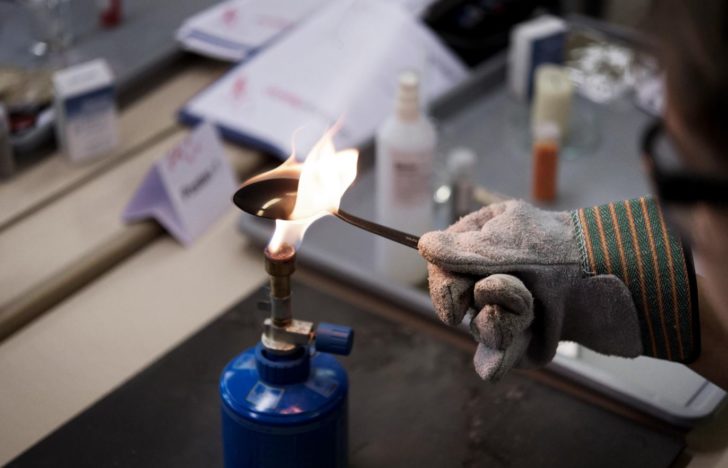Fighting against skill shortage with diapers

Schools in Aargau are pioneering with a pilot project: 1000 secondary school classes are experimenting in nanotechnology - with diapers among other things. The intended purpose of the project is to spark excitement among students. Which seems to be working.
"Babys pee, and pee, and pee", teacher Monica Drigo says. She then distributes diapers to all of her students and instructs them to carefully cut them open. The third-year students at Bezirksschule Muri then extract the cotton and powder inside, put both into a plastic bag and separate the powder more thoroughly from the cotton. The powder placed into a beaker and water is added. The two components, water and powder, immediately clump together. One gram of this powder can absorb approximately one deciliter of water, or the hundred-fold of its own weight, as the students determine in this experiment. A diaper containing six grams of powder can absorb six deciliters of liquid without the baby's bottom getting wet. But how is this made possible? Thanks to nanotechnology.
Teaching Mint-subjects in attractive manner
This diaper experiment is one of 32 experiments contained in an experimental kit called "SimplyNano 2". The Bezirksschule in Muri, AG is the first one to use the experimental kit in their classes. The entire canton Aargau has equipped schools with a total of 550 such kits. They are to be implemented in a thousand regular classes or project weeks beginning with the start of the new school year. 99 teachers were instructed in eight accompanying courses.
The costs of 400'000 Swiss francs were distributed equally between the canton and a number of sponsors. Head of the educational department of Aargau, Alex Hürzeler thinks of these nano-kits as an innovative and forward-thinking pilot project to spark the interest of pupils for occupational fields within the technical and scientific realm. The skill shortage is especially pronounced within the so called Mint-field, which entails professions in mathematics, informatics, science and technology.
The teachers face the challenge of making these fields attractive to their students. For Monica Drigo, it is clear that "students need to have fun and gain some pleasure." Accordingly, it is stipulated new curricular guide Lehrplan 21 that students should "engage in science by observing precisely, formulate their own questions, and explore phenomena by oneself." Being a multidisciplinary field, nanotechnology is well suited for these goals.
Tinkering in a mini-lab
Because it is compatible with the Lehrplan 21, the "SimplyNano 2" experimental kit is now used across separate subjects for all classes of one year in Muri. After the experiment with the diapers, Monica Drigo's students spend the afternoon working independently on further experiments. The kit offers a large variety of unperilous experiments with many different materials: a peacock feather, granular material in powder form, paper clips which can be bent over and over and simply brought back into its original shape by heating it over a flame, a fire alarm as well as several substances and powders which can be found in cosmetics, textiles or packaging materials.
The live gecko that is crawling up and down the walls of a glass terrarium does not come with the experimental kit, of course. But it helps with visualization of the gecko-effect, the especially strong adhesive forces at its feet. Many more effects are tested this afternoon, such as the the lotus-effect, the salvinia-effect and the flip-flop-effect, or high performance isolation materials are closely inspected. Time flies by as the students are working in concentrated manner. "Very cool", is one among many positive comments about the new form of teaching, "something out of the ordinary", "lifelike", "exciting", "quite diverse", "appetite for more". Nanotechnology didn't sound very interesting at first, says one student. At the end of class she said: "Wow, it was very fascinating."
Updating the image
The experimental kits were developed by the Innovation Society, St. Gallen and the SimplyScience foundation, which has dedicated itself to the advancement of science. Christoph Meili, CEO of the Innovation Society, explains: "We try to show these young people what possibilities there are in the Mint-professions." Their image should be updated and improved, especially for girls.
The teacher's association of Aargau was sceptical at first, because they feared product placement due to the sponsoring of the project. The nano-kit is completely free of any advertising material, however. Meili and the SimplyScience foundation are now hoping for further use across the cantonal boundaries of Aargau: They are hoping for a preferably nationwide use of their scientific teaching medium.
Source: Jörg Krummenacher, NZZ
https://www.nzz.ch/schweiz/ein-koffer-gegen-den-mangel-an-fachkraeften-ld.1434870
Image slideshow: https://www.nzz.ch/schweiz/bildstrecke/nanotechnologie-mit-wow-effekt-ld.1439019#lg=1&slide=0
Image source: Annick Ramp, NZZ